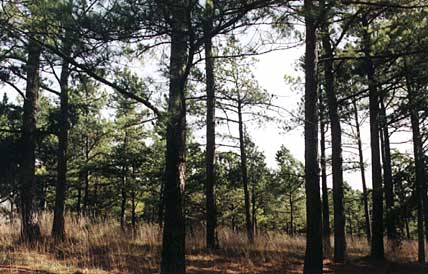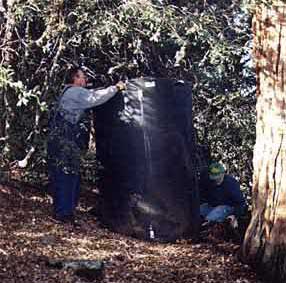|
|
|
|
"I keep six honest serving men (they taught me all I know).
Their names are What and Why and When, and How and Where and Who."
-- Rudyard Kipling, The Serving Men
Millennium Update (January 2000)
Angelina Unit
The Angelina Unit has made huge strides in the past year. As is apparent from files # 23 & 24, the Nursery Areas have been fully developed. (Since the shade clothes were installed, we now call the nurseries Ombarium (singular) or Ombaria (plural). This means shaded nursery -- well, I can't find this word in Webster's unabridged dictionary, but an expert says it is the correct word.) One can see the list of original 500 seedlings planted (~1/99) in file #23 "Angelina Experimental Database" although it can only be viewed in a text with lines format on the internet and this version is not current. To obtain a current, much more easily studied Box format printed in landscape style (all columns on one page), please use the website email to request same and The Pinetum will send a copy to you via the "snail mail" (U.S. Postal Service).
The next integral step has also occurred. Many of the larger Ombaria trees have been moved to their final growing places in the fields, where these trees will grow to be majestic specimens which will comprise the final layout of the Angelina Unit. Map/drawings are available now (snail mail), and eventually they will be available on the Pinetum website. There are 158 trees in the field, about 119 of which were transplanted from the Ombaria and 39 planted de novo. The database (updated version, now available by snail mail) has been expanded to include these trees by designated areas (they won't have the detailed addresses that the Ombaria trees have).
The transplanting was a major task, accomplished in just one week, thanks to the great physical effort of a certain of the Board of Directors (a "working" Board has a special meaning at the pinetum). The timing was forced by the pleasantly surprising rapid rate of growth of many seedlings planted only one year ago. Especially many of the Cupressus, Taxodium, and Pinus species were rapid growers, reaching the upper limit of practical transplant size. The height "winners" were Cupressus torulosa (Bhutan Cypress) at 7-1/2 feet tall, although one of the Dawn Redwoods and one of the Pond Cypresses had grown to 7 feet, at which point they were limited by the shade cloth. Also, several pines were in the 4 to 5 foot range.
|
|
|
|
Pearson Creek Unit
The Pearson Creek Unit has made progress in quite another way. The overall theme here is reduction. A total of 80 trees were removed during the past year, mostly thinning to promote overall health of the Unit by relieving crowding. The greatest number removed were Pinus banksiana (Jack Pine) (24) and thinning was also done throughout the Minipinetum, including P. virginiana, resinosa, strobiformis, contorta latifolia, and echinata. Also 13 P. taeda were removed to alleviate crowding, with concern about focal foliage stunting.
There was one ice storm (January) and one heavy snow fall (March) which did surprisingly little damage, but did result in "leanovers" (roots pulled out) of some P. banksiana and "bendovers" (trunks bend) of a few P. echinata, in both cases resulting in removal of most of these trees although some of the P. echinata were straightened out (an old story for this species).
Pine wilt nematode killed 5 trees this year -- three P. banksiana (Jack Pine), one P. Contorta contorta (Shore Pine) and one P. contorta latifolia (Lodgepole Pine). All were removed promptly -- it is hoped that the thinning of the Jack Pine will eventually result in healthier trees which can resist the long horn beetle (Monochamus carolinensis) which is the vector for this fatal infestation.
The cause of the one or two per year loss of trees in the major Eastern White Pine area has been established as Verticicladiella procera (a.k.a. Leptographium) root rot. This ground has been acidified with sulfur, an experimental attempt to stop it. There also presently is one Eastern White in this area which has been "see-saw" declining over the past three years. (maybe phytopthora root rot?). We shall remove this tree and have it thoroughly examined. There is some suspicion that this could be the cause of stunted foliage we see in some of our Loblolly pines. Perhaps a long cold winter with deep ground freezing (killing Phytophthora cinnamoni) like in the old days might be just what we need.
Several replacements were planted in the region around the spring (which we had inappropriately named the "microclimate". "SpringBank" would be a better name. This map (in file #10) has yet to be updated.
In the Micropinetum area, the major effort was to disperse Pinus palustris (Longleaf Pine) widely throughout this area, partly by transplanting and partly from de novo plantings. These trees are beginning to grow vigorously and are inherently difficult to transplant. They were concentrated in one small area and so the effort to spread them out has begun. Since most of the Micropinetum trees are slower growing and smaller species (file #36), the Longleaf pine will make an attractive overstory. There are now 27 of them scattered about the Micropinetum, although a few are still too close and will ultimately have to be removed. One caveat: the past few winters have been mild, so will the Longleaf pine be able to survive our more severe winters? They are beautiful trees (file #19) and will be a glorious addition to Pearson Creek, if the odds agains those who practice zonal denial can be overcome!

Loblolly and Shortleaf Pine -- Pearson Creek
Alder Springs Unit
The Alder Springs Unit activity for this year included road building, manzanita clearing, completion of the survey/marking of the outer boundaries and the beginning of an East boundary fence. The trees planted (file #25) were watered by hand and did exceptionally well (thanks to the diligence of an angel) for their late planting date (July). In early 2000, a more sophisticated watering system will be built.

Installing Water Tank